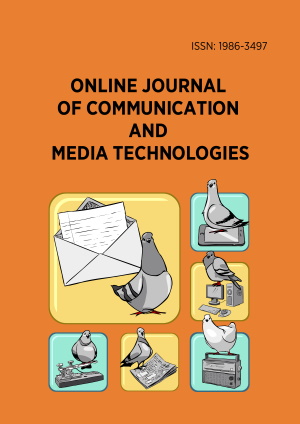Research Article
Social proof is ineffective at spurring costly pro-environmental household investments
More Detail
1 Department of Sociology/ICS, Utrecht University, Utrecht, THE NETHERLANDS2 European University Institute, Fiesole, ITALY* Corresponding Author
Online Journal of Communication and Media Technologies, 13(4), October 2023, e202351, https://doi.org/10.30935/ojcmt/13655
Published Online: 09 September 2023, Published: 01 October 2023
OPEN ACCESS 5042 Views 2529 Downloads
ABSTRACT
One of the most popular techniques of persuasion in online marketing is social proof, also referred to as social validation. It takes advantage of the fact that when other individuals have decided in favor of a particular behavior people are more likely to follow that behavior as it is perceived as more valid. Yet there is a theoretical reason to be skeptical about the effectiveness of this persuasion technique for the encouragement of more costly investment decisions taken under high uncertainty. This study investigated the effectiveness of social proof in influencing consumer responses to calls for action on a bank’s sustainable home improvement website. A first field experiment investigated whether participants engaged more with a webpage that provided a personalized testimonial or informed users that thousands of other clients had used the bank’s sustainable home improvement services. A second field experiment encouraged clients to use the bank’s services to obtain solar panels and we again investigated whether clients engaged more with a webpage that provided a personalized testimonial rather than without such a testimonial. Clients were directed to these webpages through a newsletter that is distributed to half a million clients of the bank. Overall, our evidence suggests that messages of social proof are ineffective at urging customers to consider larger pro-environmental household investments, let alone making those investments.
CITATION (APA)
Schneider, P. T., Buskens, V., & van de Rijt, A. (2023). Social proof is ineffective at spurring costly pro-environmental household investments. Online Journal of Communication and Media Technologies, 13(4), e202351. https://doi.org/10.30935/ojcmt/13655
REFERENCES
- Abrahamse, W., & Steg, L. (2013). Social influence approaches to encourage resource conservation: A meta-analysis. Global Environmental Change, 23(6), 1773-1785. https://doi.org/10.1016/j.gloenvcha.2013.07.029
- Centola, D., & Macy, M. (2007). Complex contagions and the weakness of long ties. American Journal of Sociology, 113(3), 702-734. https://doi.org/10.1086/521848
- Chung, T., & Mallery, P. (1999). Social comparison, individualism-collectivism, and self-esteem in China and the United States. Current Psychology, 18(4), 340-352. https://doi.org/10.1007/s12144-999-1008-0
- Cialdini, R. B. (2001). The science of persuasion. Scientific American, 2(282), 76-81. https://doi.org/10.1038/scientificamerican0201-76
- De Wit, J. B. F., Das, E., & Vet, R. (2008). What works best: Objective statistics or a personal testimonial? An assessment of the persuasive effects of different types of message evidence on risk perception. Health Psychology, 27(1), 110-115. https://doi.org/10.1037/0278-6133.27.1.110
- Donnell, C. C., Iafrate, L. F., & Worthington, S. W. (2022). The “five star” fallacy: An analysis of online reviews and testimonials of dental practices in Northern England. British Dental Journal. https://doi.org/10.1038/s41415-022-4977-0
- Elgaaied-Gambier, L., Monnot, E., & Reniou, F. (2018). Using descriptive norm appeals effectively to promote green behavior. Journal of Business Research, 82, 179-191. https://doi.org/10.1016/j.jbusres.2017.09.032
- Fenko, A., Keizer, T., & Pruyn, A. (2017). Do social proof and scarcity work in the online context? ICORIA (International Conference on Research in Advertising) 2017 Proceedings, July, 1-9. https://www.researchgate.net/publication/318164686
- Festinger, L. (1954). A theory of social comparison processes. Human Relations, 7(2), 117-140. https://doi.org/10.1177/001872675400700202
- Goldstein, N. J., Griskevicius, V., & Cialdini, R. B. (2007). Invoking social norms: A social psychology perspective on improving hotels’ linen-reuse programs. Cornell Hotel and Restaurant Administration Quarterly, 48(2), 145-150. https://doi.org/10.1177/0010880407299542
- Granovetter, M. (1978). Threshold models of collective behavior. American Journal of Sociology, 83(6), 1420-1443. https://doi.org/10.1086/226707
- Han, H., & Hyun, S. S. (2018). What influences water conservation and towel reuse practices of hotel guests? Tourism Management, 64, 87-97. https://doi.org/10.1016/j.tourman.2017.08.005
- Hausman, A. V., & Siekpe, J. S. (2009). The effect of web interface features on consumer online purchase intentions. Journal of Business Research, 62(1), 5-13. https://doi.org/10.1016/j.jbusres.2008.01.018
- Jeong, H. J., & Kwon, K. N. (2012). The effectiveness of two online persuasion claims: Limited product availability and product popularity. Journal of Promotion Management, 18(1), 83-99. https://doi.org/10.1080/10496491.2012.646221
- Kemp, E., Min, K. S., & Joint, E. (2015). Selling hope: The role of affect-laden health care advertising in consumer decision making. Journal of Marketing Theory and Practice, 23(4), 434-454. https://doi.org/10.1080/10696679.2015.1049688
- Lehmann, S., & Ahn, Y.-Y. (2018). Complex spreading phenomena in social systems: Influence and contagion in real-world social networks. Springer. https://doi.org/10.1007/978-3-319-77332-2
- Maier, M., Bartoš, F., Stanley, T. D., Shanks, D. R., Harris, A. J. L., & Wagenmakers, E. J. (2022). No evidence for nudging after adjusting for publication bias. Proceedings of the National Academy of Sciences of the United States of America, 119(31), 10-11. https://doi.org/10.1073/pnas.2200300119
- Meyers, G. (2021). Getting the seal of approval: Maximizing patient feedback. BDJ in Practice, 34(5), 23. https://doi.org/10.1038/s41404-021-0733-4
- Ministry of Economic Affairs and Climate Policy. (2020). Klimaatplan 2021-2030. https://climate-laws.org/rails/active_storage/blobs/eyJfcmFpbHMiOnsibWVzc2FnZSI6IkJBaHBBaThNIiwiZXhwIjpudWxsLCJwdXIiOiJibG9iX2lkIn19--c85adb7ba657569ead9023707fbc96241e3fb034/NLD108819.pdf
- Rashotte, L. (2007). Social influence. The Blackwell Encyclopedia of Sociology. https://doi.org/10.1002/9781405165518.wbeoss154
- Schultz, P. W., Nolan, J. M., Cialdini, R. B., Goldstein, N. J., & Griskevicius, V. (2018). The constructive, destructive, and reconstructive power of social norms: Reprise. Perspectives on Psychological Science, 13(2), 249-254. https://doi.org/10.1177/1745691617693325
- Thaler, R., & Sunstein, C. (2009). NUDGE: Improving decisions about health, wealth, and happiness. In Nudge: Improving decisions about health, wealth, and happiness (Vol. 47). Penguin Books.

 The articles published in this journal are licensed under the CC-BY Creative Commons Attribution International License.
The articles published in this journal are licensed under the CC-BY Creative Commons Attribution International License.